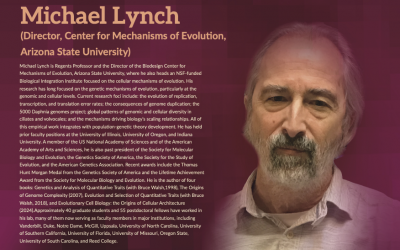Title: Principles of Evolutionary Overdesign and Underperformance
Abstract: For over a century, most biologists have been convinced that all aspects of biodiversity have been driven entirely by natural selection, with stochastic forces and mutation bias playing a minimal role. However, this is not the case at the molecular and cellular levels, where diverse traits scale with cell/organism size in ways that cannot be explained by optimization and/or speed vs. efficiency arguments. These include aspects of gene/genome architecture, intracellular error rates, the multimeric nature of proteins, swimming efficiencies, and maximum growth rates.
Although natural selection may be the most powerful force in the biological world, it is not all powerful, and the power of random genetic drift ultimately dictates what selection can and cannot accomplish. Many prokaryotes may reside in population-genetic environments where the limits to selection are indeed dictated only by the constraints of cell biology. However, in the eukaryotic domain, larger organism size is typically associated with a reduction in effective population size (Ne), enabling the accumulation of very mildly deleterious mutations, which in turn induces coevolutionary side effects leading to more complex and less efficient phenotypes.
This general conclusion is embodied in the drift-barrier hypothesis, which postulates that traits under persistent directional selection become stalled when further increments in improvement are thwarted by the power of random genetic drift. Integration of biology’s three engines of quantitative theory – population genetics, biophysics, and biochemistry, combined with observations from cellular bioenergetics, is providing a platform for the emergence of a formal field of evolutionary cell biology.
About the speaker: Michael Lynch is Regents Professor and the Director of the Biodesign Center for Mechanisms of Evolution, Arizona State University, where he also heads an NSF-funded Biological Integration Institute focused on the cellular mechanisms of evolution. His research has long focused on the genetic mechanisms of evolution, particularly at the genomic and cellular levels. Current research foci include: the evolution of replication, transcription, and translation error rates; the consequences of genome duplication; the 5000 Daphnia genomes project; global patterns of genomic and cellular diversity in ciliates and volvocales; and the mechanisms driving biology’s scaling relationships. All of this empirical work integrates with population-genetic theory development. He has held prior faculty positions at the University of Illinois, University of Oregon, and Indiana University. A member of the US National Academy of Sciences and of the American Academy of Arts and Sciences, he is also past president of the Society for Molecular Biology and Evolution, the Genetics Society of America, the Society for the Study of Evolution, and the American Genetics Association. Recent awards include the Thomas Hunt Morgan Medal from the Genetics Society of America and the Lifetime Achievement Award from the Society for Molecular Biology and Evolution. He is the author of four books: Genetics and Analysis of Quantitative Traits (with Bruce Walsh,1998), The Origins of Genome Complexity (2007), Evolution and Selection of Quantitative Traits (withBruce Walsh, 2018), and Evolutionary Cell Biology: the Origins of Cellular Architecture (2024).Approximately 40 graduate students and 55 postdoctoral fellows have worked in his lab, many of them now serving as faculty members in major institutions, including Vanderbilt, Duke, Notre Dame, McGill, Uppsala, University of North Carolina, University
of Southern California, University of Florida, University of Missouri, Oregon State, University of South Carolina, and Reed College.
This lecture is part of the program "Theoretical and empirical approaches to understand polygenic adaptation".


